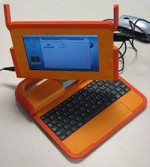Cheap laptops bring tech to the needy

Nicholas Negroponte, founder of the non-profit group One Laptop Per Child (OLPC), wants to stop the spread of poverty throughout the world. But instead of filling the void of third-world economic backpedaling, he’s turning to poverty stricken nations’ strongest national resource: children.
According to the OLPC Web site, the mission of the organization “is to provide children around the world with new opportunities to explore, experiment and express themselves.”
The methodology: Give each child a laptop that is durable, requires no electrical outlets and is connected to the Internet all the time, practically anywhere, and is easy to not only use, but to program – all for $100.
It may seem like a pipe dream, but where there’s a will – and, in Negroponte, a former head of the MIT media lab supported by world-renowned education specialists – there is a way.
The XO laptop test machines rolled off Quanta’s Shanghai assembly last November. The XO is more than a new computer or a gadget; it is designed to bring education to children of the world who are starved not only for food, but also for knowledge.
“This is not just a matter of giving a laptop to each child, as if bestowing on them some magical charm,” former United Nations Secretary General Kofi Annan said at the World Symposium on the Information Society in 2005. “The magic lies within each child, within each scientist, scholar or just plain citizen-in-the-making. This initiative is meant to bring it forth into the light of day.”
Designed to use far less energy than a normal laptop, the XO can be human-powered where there is no electricity. A crank, pedal and pull cord offer all the power the XO needs when there are no outlets to recharge the batteries.
OLPC states that the computers will “uniquely foster learning by allowing children to think, and then think about thinking, in ways that are otherwise impossible. Using the XO as both their window on the world, as well as a highly programmable tool for exploring it, children in emerging nations (will be) opened to unlimited knowledge and to their own creative and problem-solving potential.”
Rwanda, Uruguay, Libya and Nigeria have committed to adopting the program, but have not yet reached the five million orders necessary to start the assembly line. Still, not everyone is excited about the XO – India wants no part of the OLPC project. Indian Education Secretary Sudeep Banerjee told Indian newspaper The Hindu that the country “need(s) classrooms and teachers more urgently than fancy tools,” adding that the program isn’t “mature enough to be taken seriously at this stage” and is “pedagogically suspect.”
Linux – a free, open-source operating system – runs on the laptops and the creators of OLPC said they feel it offers a unique opportunity for the children to learn how to create their own programs and collaborate with their peers.
“Fifty percent of the cost of your laptop is sales, marketing, distribution and profit. We have none of that. Seventy-five percent of the rest of your laptop is used just to support the operating system and the obesity of the software in it,” Negroponte said as keynote speaker for the 2007 National Education Computing Conference.
Dan Williams of Red Hat Inc., a software company that develops an eponymous version of the Linux operating system, said, “We’re trying to strip out everything that’s not absolutely necessary. We’ll be able to get a very optimized, very fast, very small footprint.”
XO’s wi-fi antennas connect to other XOs in the vicinity to form a peer-to-peer wireless mesh network. The signal leapfrogs machines and pools their resources to form a large network that actually gets stronger as more users connect.
Negroponte said in an interview with Newsweek that the out-of-the-box price of the XO would be around $138 in the second quarter of 2007, but the price would drop to approximately $100 by the end of 2008 and to $50 by the end of 2010.
“We’re not going to keep adding features,” Negroponte said. “We’re going to keep the features constant and watch the price go down.”






